Queen Olga's Pearl and Diamond Devant de Corsage or Stomacher
Open FREE Unlimited Store Join Our Newsletter
Origin of Name
What is a Devant de Corsage ?
"Devant de Corsage" in French means "front blouse," which was known as "Stomacher" in English, the decorative often heavily embroidered or jeweled, V-shaped panel of stiff material inserted into the bodice of a woman's dress, and worn over the chest and ending at a point just above the stomach. Stomachers were a feature of the formal dresses of both men and women in the 15th and 16th centuries, but were in and out of fashion throughout the 17th and 18th centuries. In the 18th-century, the terms "Devant de Corsage" and "Stomacher" came to be applied to jeweled ornaments, usually a large triangular brooch, worn on the stomacher or the center of the woman's dress bodice. Such ornaments, also known as corsage brooches, were quite popular in the Edwardian period, equivalent to the Belle Époque period in France.
The original owner of the corsage was Queen Olga of Greece, from whom the ownership passed to Princess Marie Bonaparte, Princess Eugenie of Greece and Denmark and finally to her son Prince Carlo Alessandro della Torre e Tasso, 3rd Duke of Castel Duino
Queen Olga's Pearl and Diamond Devant de Corsage or Stomacher was originally a piece of jewelry in her personal collection, and the photograph of the Queen shown below, show her wearing the historic corsage, together with a collar or choker consisting of three strands of pearls and two strands of diamonds, alternating with one another, and an additional loose pearl strand, that looks like a Princess (17-20 inches). The ownership of the historic corsage, passed from Queen Olga to her daughter-in-law, Princess Marie Bonaparte, and then to her granddaughter Princess Eugenie of Greece and Denmark, and through her to her great-grandson Prince Carlo Alessandro della Torre e Tasso, 3rd Duke of Castel Duino.
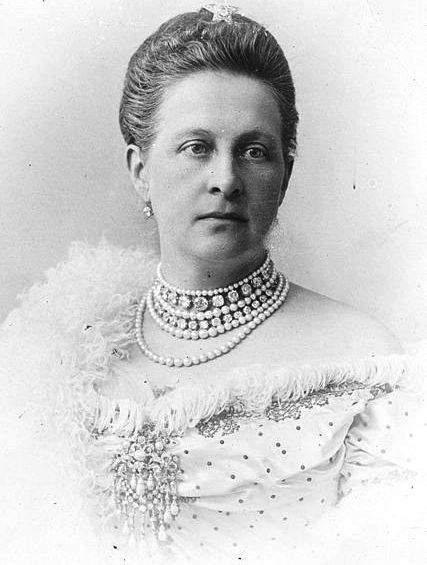
Queen Olga of Greece wearing the Devant de Corsage and a pearl and diamond collar/choker
Characteristics of Queen Olga's Pearl and Diamond Devant de Corsage
The evolution of the devant de corsage or stomacher
Devant de corsage/stomacher, commonly known as corsage brooches were triangular shaped when they were first created and worn at the center of a woman's dress bodice in the 18th-century. As the corsage ornament evolved, the triangular shape of the brooch was initially maintained, but was modified by the addition of matching pendants carrying the same gemstones mounted on the main brooch. The number of pendants varied depending on the design of the brooch. Some corsage ornaments had only a single pendant, such as the sapphire and diamond stomacher of Queen Beatrix of Netherlands which she inherited from her predecessors. The diamond devant de corsage created for Queen Emma of Netherlands, as part of a diamond demi-parure consisting of a collet-set necklace of 34 large diamonds, and the devant de corsage, which was a wedding gift for the Queen by the people of Netherlands, consisted of three diamond pendants. Another diamond parure designed for Queen Emma of Netherlands by the Dutch Jeweler, Van Kempen in 1879, also included a diamond devant-de-corsage with three diamond pendants.
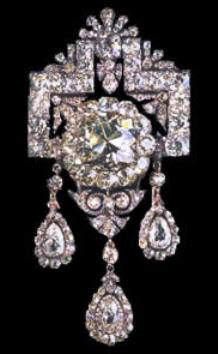
Queen Emma's Devant de Corsage- Wedding gift from the people of Netherlands.
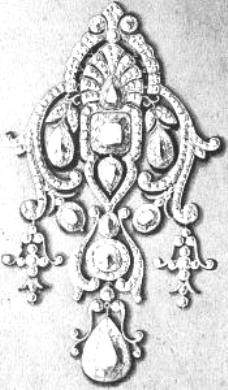
Devant de Corsage designed by Van Kempen for Queen Emma
Queen Olga's Pearl and Diamond Devant de Corsage depicting both mathematical and artistic precision is a living testimony to the designing skills of the unknown 19th-century jewelry designer
Design features of the main triangle-shaped brooch
A study of Queen Olga's Pearl and Diamond Devant de Corsage shows that the triangular shape of traditional corsage brooches has been maintained in the main brooch, which consists of a cartouche of entwined ribbon and scroll motifs, set throughout with cushion-shaped diamonds. Three large cushion-shaped diamonds are mounted on the main brooch, one as the centerpiece of the sunburst at the top of the triangle, and two on either side at the base of the triangular brooch. Three large white pearls are also mounted on the main brooch, a button-shaped pearl, just below the sunburst, and two almost spherical pearls on either side of it, positioned somewhere in the middle of the two sides of the triangle. Three drop-shaped pearls, a large drop in the center and two smaller drops on either side, are suspended directly from the center of the base of the triangular-shaped main brooch, by a bell-cap arrangement mounted with small diamonds.
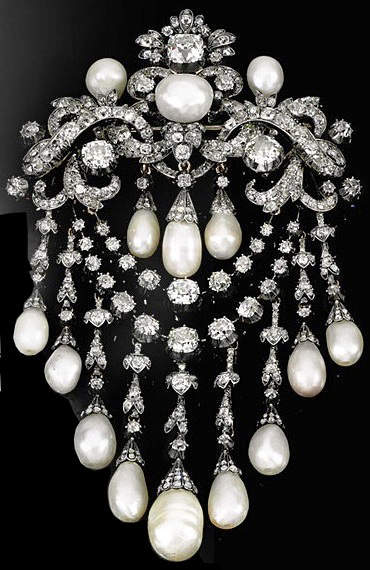
Queen Olga's Pearl and Diamond Devant de Corsage
© Sotheby's
Design features of the most spectacular lower part of the brooch
The most spectacular design feature of this historic devant de corsage is the elaborate swag of pearl and diamond drops and diamond chains hanging from the scrolls at the base of the triangular main brooch. There are two diamond chains in the brooch. The first, shorter, festoon, diamond chain, consisting of 9 cushion-shaped diamonds, situated immediately below the three pearl drops hanging from the base of the triangle-shaped main brooch, connects the two scrolls on either side. The second, longer, festoon, diamond chain, consisting of 13 cushion-shaped diamonds, also arising from symmetrical points on the scrolls situated on either side, is the most elaborate of the two chains, from which hangs seven pearl and diamond drops. The pearls are not perfect drop-shaped, but drop-shaped baroque pearls. They are white with a brilliance and luster characteristic of saltwater pearls; a luster that has stood the test of time, and prevailed for the last 150 years.
The pearls are suspended by a bell-cap arrangement, the bell-caps being mounted with diamonds. Diamonds are also mounted on the decorative motifs situated on the wire that suspends the pearl drops. The longest pearl and diamond drop is situated along the median line of the corsage brooch, and is attached to the mounting of the largest cushion-shaped diamond on the chain. The three pairs of pearl and diamond drops situated on either side of the longest and median pearl and diamond drop, gradually decrease in length, so that the bottom of the pearls roughly lie along a V-shaped line. The first pair of pearl and diamond drops lying immediately on either side of the median pearl drop, are attached to the mounting of the diamonds, lying immediately next to the largest cushion-shaped diamond. The second pair of pearl and diamond drops hang from the mountings of diamond No.3, on either side of the central cushion-shaped diamond. The third pair of pearl and diamond drops hang from the mountings of diamond No.6 on either side of the central cushion-shaped diamond. The fourth pair of pearl and diamond drops hang directly from the scroll, and unlike the other drops are not attached to the diamond festoon chain. Thus, altogether there are four pairs of symmetrical pearl and diamond drops and the median longest pearl and diamond drop, making a total of nine pearl and diamond drops hanging from the lower side of the corsage brooch. Queen Olga's Pearl and Diamond Devant de Corsage can thus be described as perfect example of a corsage brooch, depicting both mathematical and artistic precision and a living testimony to the designing skills of the unknown 19th-century jewelry designer.
History of Queen Olga's Pearl and Diamond Devant de Corsage
The historic corsage was probably given as a gift by Queen Olga to her daughter-in-law Princess Marie Bonaparte at the time of her marriage to Prince George, Queen Olga's second son
The pearl and diamond devant de corsage or stomacher, the subject of this webpage, is a renowned piece of jewelry with a historic provenance of over 150 years, and associated with the nobility of Russia and Greece. The corsage brooch originally belonged to Queen Olga of Greece, born as Grand Duchess Olga Constantinovna of Russia in 1851, a granddaughter of Czar Nicholas I and first cousin of Czar Alexander III, who married King George I of Greece in 1867, and was his Queen consort until his death in 1913. In 1907, when Queen Olga's second son Prince George of Greece and Denmark married Princess Marie Bonaparte, a great-grandniece of Emperor Napoleon I of France, she probably gave the pearl and diamond, devant de corsage as a gift to her new daughter-in-law.
The Pearl and Diamond Devant de Corsage was inherited by Princess Marie Bonaparte's only daughter Princess Eugenie of Greece and Denmark
The corsage then became identified with Princess Marie Bonaparte, who wore it for all formal occasions and had been photographed wearing it with other pearl jewelry, such as long strands of pearl necklaces and pearl drop earrings, together with her signature piece, "Diademe aux etoiles" the diamond stars tiara. The pearl and diamond devant de corsage was then inherited by Princess Eugenie of Greece and Denmark, the youngest child and only daughter of Princess Marie Bonaparte and Prince George of Greece and Denmark. Princess Eugenie of Greece and Denmark, first married Dominic Radziwill in 1938, in Paris but they were divorced after 8 years of marriage in 1946. The marriage produced two children, Princess Tatiana Maria Radziwill and Prince George Andreas Radziwill.
The historic corsage was finally inherited by Prince Carlo Alessandro della Torre e Tasso, Princess Eugenie's only son by her second marriage to Prince Raymundo, della Torre e Tasso, 2nd Duke of Castell Duino
Princess Eugenie remarried in 1949, and her second husband was Prince Raymundo, della Torre e Tasso, 2nd Duke of Castell Duino. This marriage also ended in divorce in 1965, and produced one son, Prince Carlo Alessandro, della Torre e Tasso, 3rd Duke of Castel Duino, who was born in 1952, in France, and is the current head of the Castel Duino branch of the House of Thurn and Taxis. The pearl and diamond devant de corsage belonging to Princess Eugenie of Greece, was inherited by her son H.S.H. Prince Carlo Alessandro, who put it up for sale at the Sotheby's Magnificent Jewels and Noble Jewels sale, held in Geneva, on May 11, 2010.
Queen Olga's Pearl and Diamond Devant de Corsage registers a significantly enhanced price at the Sotheby's Magnificent Jewels and Noble Jewels sale held in Geneva on May 11, 2010
Queen Olga's Pearl and Diamond Devant de Corsage was allotted Lot No.374, at the Sotheby's "Magnificent Jewels and Noble Jewels" sale held in Geneva, on May 11, 2010. The lot was accompanied by report no.56209, issued by the Swiss Gemstone Research Foundation (SSEF) certifying that the pearls in the corsage brooch are all saltwater natural pearls. A pre-sale estimate of 43,000-63,000 CHF was placed on the historic devant de corsage, but the renowned piece of jewelry eventually registered a hammer price of 164,500 CHF, which was almost 4 times the lower pre-sale estimate and 2½ times the upper pre-sale estimate. The significantly enhanced price realized for the Devant de Corsage, was partly due to its historic provenance and partly due the natural origins of the pearls incorporated in it.
Queen Olga of Greece - A short biography
Her birth and royal descent
Olga, who was born in 1851 in Pavlovsk, as a Princess of Saxe-Altenburg, was the daughter of Grand Duke Konstantin Nikolayevich of Russia and Grand Duchess Alexandra of Saxe-Altenburg. She was a granddaughter of Tsar Nicholas I, and a first cousin of Tsar Alexander III, and subsequently, through her son Andrew became the paternal grandmother of Prince Philip, the Duke of Edinburgh, the husband of Queen Elizabeth II of the United Kingdom. She also became the great-grandmother of Queen Sofia of Spain, through her eldest son King Constantine I of Greece.
Her marriage to George I, the Prince of Denmark, imposed as King on the nation of Greece by the Great Powers in 1863
She met her future husband, the young King of Greece, George I - a prince of Denmark who was thrust upon the throne of Greece, by the great powers of the time, the United Kingdom, France and Russia, with the consent of the people of Greece, who ironically still favored a monarchy instead of a republic, the form of government first preached by its great philosophers like Plato - when she was just 12 years old. George I had visited Russia in 1863, to express his gratitude to Tsar Alexander II who sponsored him to the throne of Greece. In 1867, George I, visited Russia again, to meet with his sister Dagmar, who had married Tsarevitch Alexander, the heir to the Russian throne, in 1866. During this visit, he met Olga again, and they fell in love, and married the same year in October. Olga was 16 years old at the time of her marriage and George I was 22.
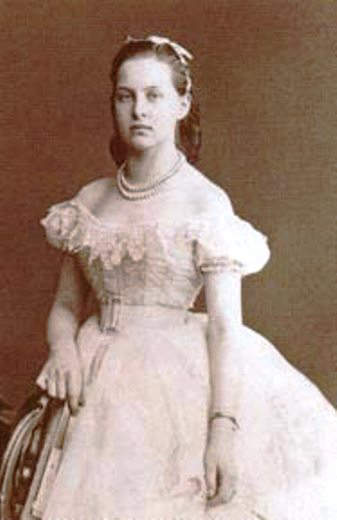
Grand Duchess Olga Constantinova just before her marriage to King George I of Greece
King George I and Queen Olga's efforts in identifying themselves with the hopes and aspirations of the Greek people
George and Olga who were Danish and Russian by descent, and were elevated to the status of King and Queen of Greece, by the will of the people of Greece, took great effort in identifying themselves with the hopes and aspirations of the people of their adopted nation, Greece, and particularly their yearning to reunite their country, parts of which were still under the control of the Ottoman Turks, the British and the French. They learnt the Greek language, identifying themselves with their religion, customs and traditions, and extending royal patronage to all events that needed their participation. George on his part assumed a more informal role as king, frequently seen in public places and the streets of Athens, mingling with the ordinary masses, projecting his image as the people's king. He also established a rapport with the National Assembly, which under his insistence adopted a new constitution in 1864, making way for a constitutional monarchy and a unicameral legislature, whose members were elected by direct, secret, universal male suffrage. the first of its kind in modern Europe. Due to various reasons including a low literacy rate, the constitution did not produce a stable government for Greece, and during George I's reign as king which lasted almost 50 years, there were 21 general elections and 70 different governments that ruled Greece.
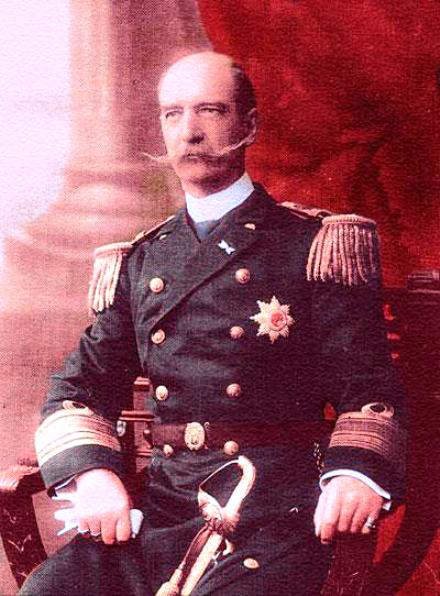
King George I of Greece
George I's foreign policy was linked to his relationship with the ruling families of the UK, Russia and Prussia, which he used effectively to secure the reintegration of Thessaly with Greece
George I used his relationship with the ruling families of the United Kingdom, Russia and Prussia, to steer the foreign policy of his nation. He established a close relationship with his brother-in-law Prince Edward, the Prince of Wales, whose help he sought in re-uniting his country. His efforts proved successful when in 1878, at the Congress of Berlin following the Russo-Turkish war, he staked a claim to Crete, Epirus and Thessaly, and Turkey under pressure from the British and the French finally agreed to grant all of Thessaly and a part of Epirus to Greece, at the Conference of Constantinople held in 1880. In his continued attempts to reunite Crete, other Aegean islands and the whole of Epirus with Greece he suffered several setbacks, such as opposition by the great powers including Britain, and a crushing defeat at the hands of the Ottoman Turks in April 1897.
George I's greatest triumph came in 1912, when his reorganized army dealt a crushing blow on Ottoman Turkey realizing the long-cherished dreams of his people in re-uniting the Greek nation
However, his greatest triumph came in 1912, when his re-organized, well-trained and well-equipped, 200,000-strong, Greek army dealt a crushing and decisive blow to the Ottoman army, defeating them for the first time, in the First Balkan War, which not only saw Greece expand territorially taking control of southern Epirus, Macedonia, Crete, and some of the Aegean islands, but also its population increasing almost two-fold. Following their lightning victory, that led to the capture of Thessaloniki or Salonika, the capital of Macedonia, and the second largest city in Greece, George I entered Salonika triumphantly with his prime minister and the crown prince, and rode through the streets of the city, cheered by the crowds.
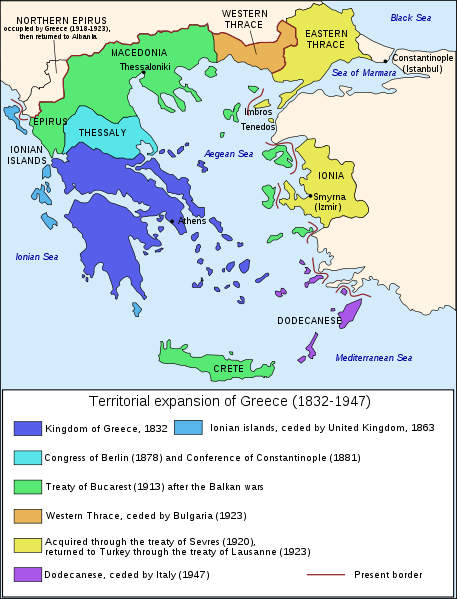
Territorial expansion of Greece (1832- 1947)
Photo: C.C
His assassination in Salonika on March 18, 1913, drove the entire Greek nation into a state of shock and mourning for the foreign king who identified himself with the hopes and aspirations of the Greek people
The king spent some time in Salonika, and like in Athens he went about the city, mingling with people, with the minimum of security. Then on that fateful day, March 18, 1913, when he was out on a walk near the White Tower of Thessaloniki, an alcoholic and vagrant by the name of Alexandros Schinas, shot him at close range in the back, throwing the entire Greek nation into a state of shock and mourning, for the foreign king who identified himself with their hopes and aspirations and restored the nations pride and glory. King George's body lay in state in Athens for five days before he was finally laid to rest in the tomb in his palace in Tatoi. Immediately after his death his eldest son Constantine I ascended the throne as the new king of Greece.
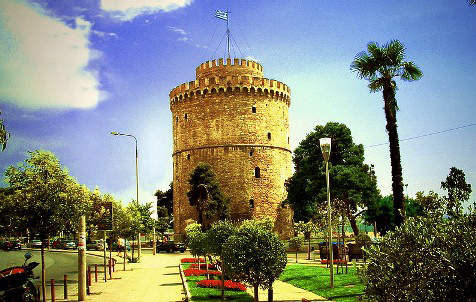
White Tower of Thessaloniki around which area King George I was assassinated
Queen Olga's service to the people of Greece
Queen Olga was George I's valuable companion and adviser throughout his long reign as the King of Greece, and supplemented her husband's efforts in realizing the hopes and aspirations of the Greek people. She took an active role in charitable work designed to help the poor and the underprivileged in society. She was instrumental in setting up two of the largest hospitals in Greece, the Evangelismos Hospital in downtown Athens and the Russian Hospital in the Piraeus. Like the king, she too insisted in continuing all her official engagements without a military guard, lest such action would create an artificial barrier between her and her humble subjects. During the Greco-Turkish war of 1897,she visited the wounded soldiers regularly in hospital, providing them with much-needed spiritual and psychological support, reading the bible to the wounded soldiers who could not read or understand the bible, written in an ancient form of Greek known as "Koine Greek," not understood by the majority of the people, who spoke Modern Greek, also known as Demotic Greek.
Queen Olga's attempts to fill the spiritual vacuum created by the use of a Bible in Greece not understood by the ordinary masses - The Evangelika Controversy
Queen Olga's realization of the existence of this spiritual vacuum in society, led to her determination to initiate a project to get the Bible translated into a version that could be understood by the common people, despite strong opposition by the conservative priesthood and orthodox theologians, who considered such moves as blasphemy and treason, tantamount to a renunciation of Greece's ancient and sacred heritage. The translation was finally published in February 1901, incorporating both the old and new texts, with the qualification that it was exclusively meant for family use at home and not in the church, and was sold far below its actual cost at one drachma. Queen Olga was supported only by the Archbishop of Athens in this laudable project, but was opposed by all puritan theologians, and the Ecumenical Patriarch Joachim III of Constantinople, and the project was finally abandoned after riots started by students of the National and Kapodistrian University of Athens who were incited by conservative professors. The controversy led to the resignation of the Archbishop of Athens and the fall of the Greek Government.
Queen Olga's death in exile in France in 1926, and her re-internment in Greece in 1936 after the restoration of the monarchy
In spite of this controversy known as the "Evangelika Controversy" Queen Olga was indeed a popular queen, loved by the people of Greece. Queen Olga died in Pau, Bearn, France, on June 18, 1926, at the age of 74 years, while the royal family, lived in exile in Italy. Her remains were first interred in Italy, but later re-interred at the Royal Cemetery, Tatoi Palace, in Greece, on November 17, 1936, after the restoration of the Greek monarchy in 1935.
You are welcome to discuss this post/related topics with Dr Shihaan and other experts from around the world in our FORUMS (forums.internetstones.com)
Related :-
1) Single-Strand Natural Pearl Necklace with Emerald and Diamond Clasp
2) Pearl and Diamond Orchid Brooch- Spanish Noble Family
External Links
1) Sotheby's Magnificent Jewels and Noble Jewels Sale, Geneva, May 11, 2010. Lot 374, Pearl and Diamond Devant de Corsage, Circa 1850.
References
1) Sotheby's Magnificent Jewels and Noble Jewels Sale, Geneva, May 11, 2010. Lot 374, Pearl and Diamond Devant de Corsage, Circa 1850.www.sothebys.com
2) Antique Terms (S) - www.antique-marks.com
3) Dictionary of Jewelry Terms - GemologyOnline.com - www.gemologyonline.com
4) Stomacher - From Wikipedia, the free encyclopedia
5) Olga Constantinovna of Russia - From Wikipedia, the free encyclopedia
6) George I of Greece - From Wikipedia, the free encyclopedia.
7) Princess Marie Bonaparte - From Wikipedia, the free encyclopedia.
8) Princess Eugenie of Greece and Denmark - From Wikipedia, the free encyclopedia.
9) Carlo Alessandro, 3rd Duke of Castel Duino
10) The First Balkan War - From Wikipedia, the free encyclopedia
11) Queen Emma's Devant de Corsage - www.royaldutchjewels.nl
Powered by Ultra Secure
Amazon (USA) Cloud Network

Founder Internet Stones.COM
Register in our Forums
| Featured In
|
|
|
|
|
|
|
|


















